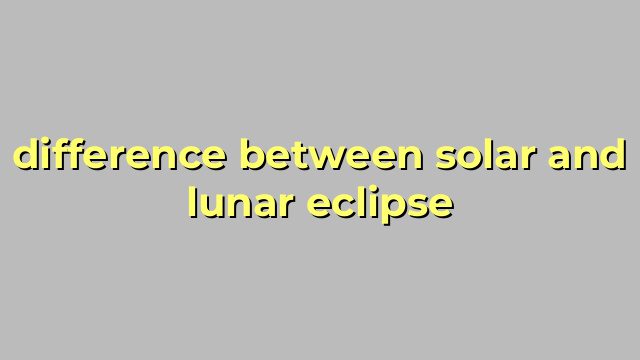The Difference between Solar and Lunar Eclipse
Eclipses have been a source of fascination, mystery, and terror for many people throughout history. Both solar and lunar eclipses are natural astronomical phenomena, but they are fundamentally different from one another.
Solar Eclipse
A solar eclipse occurs when the moon passes between the sun and the earth, casting a shadow on the surface of the earth. During this phenomenon, the sun is temporarily blotted out from view, and darkness falls in the areas where the eclipse can be seen. There are several types of solar eclipse, including total, partial, and annular eclipses.
A total solar eclipse happens when the moon completely covers the sun and the sun’s corona can be seen. A partial solar eclipse occurs when the moon only partially covers the sun. Lastly, an annular solar eclipse happens when the moon is positioned farther from the earth, making it appear smaller than the sun, and the sun’s edges remain visible, creating a “ring of fire” effect.
Lunar Eclipse
On the other hand, a lunar eclipse occurs when the earth passes between the sun and the moon, causing the earth’s shadow to be cast on the lunar surface. During this phenomenon, the moon is temporarily darkened, and its appearance changes. Lunar eclipses occur when there is a full moon, meaning that the moon is completely illuminated by the sun at the start of the eclipse.
There are three types of lunar eclipses: total, partial, and penumbral. A total lunar eclipse takes place when the earth’s position is such that the entirety of the moon is covered by its shadow. A partial lunar eclipse happens when the earth partially blocks the sun’s light from hitting the moon. Lastly, a penumbral lunar eclipse occurs when the moon only passes through the earth’s outer shadow, causing a subtle darkening of the lunar surface.
The Conclusion
In conclusion, the main difference between a solar and lunar eclipse is the position of the earth relative to the sun and moon. During a solar eclipse, the moon passes between the sun and the earth, whereas in a lunar eclipse, the earth is positioned between the sun and the moon. Both are fascinating and inspiring natural phenomena that continue to amaze people throughout the world, and it is always wise to ensure you have the necessary eye protection while observing solar eclipses.
Table difference between solar and lunar eclipse
| Solar Eclipse | Lunar Eclipse | |
|---|---|---|
| Definition | Occurs when the moon passes between the sun and the Earth, blocking the sun’s light and casting a shadow on Earth. | Occurs when the Earth passes between the sun and the moon, casting a shadow on the moon and making it appear darker. |
| Appearance | The sun appears to be blocked by the moon, creating a “ring of fire” effect or a total blackout. | The moon becomes darker and may appear reddish in color as it passes through the Earth’s shadow. |
| Visibility | Only visible in a limited geographic area, typically a narrow band on Earth’s surface. | Visible from anywhere on the night side of Earth where the moon is visible. |
| Frequency | Occur less frequently than lunar eclipses, typically once every eighteen months or so. | Occur more frequently than solar eclipses, typically twice a year. |
| Duration | Lasts only a few minutes, up to a few hours at most. | Lasts several hours, up to a few hours at most. |

